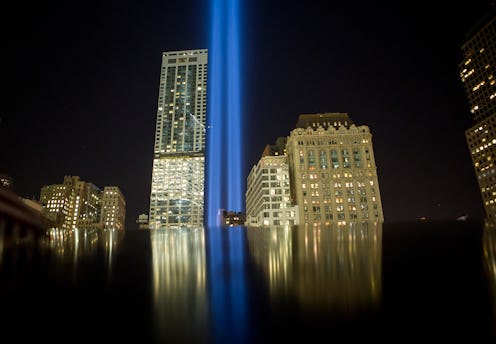News
The Stories Behind 4 Iconic Photos From 9/11
Like the rest of the country this week, my thoughts have been on remembering details from the morning of Sept. 11, 2001. The destruction of the World Trade Center left Americans in shock and terror — and awestruck that such a horrific act of terrorism was possible on American soil. In grief and disbelief, I, like much of America, was glued to the television in the aftermath of the destruction of the World Trade Center. And because of that shared experience, the most memorable, iconic images from Sept. 11 that we talk about this week will be based on the touching images and stories shared with the world from the journalists and photographers at Ground Zero: smoke and fire coming from the towers themselves, first responders rushing through debris and disaster, everyday people helping each other to safety, and seas of dazed New Yorkers evacuating lower Manhattan on foot.
Nearly 15 years after the Sept. 11 attacks, the images from that morning remain among the most emotional — and sometimes controversial — in U.S. history. And if the images themselves are enough to recall the horror and devastation of that morning, the stories behind them will truly leave you reeling. Here are some of the images that we're still talking about, 14 years later.
Edward Fine, "The Dust Man"
Edward Fine had been waiting for an elevator in the World Trade Center's North Tower when American Airlines Flight 11 crashed into the building. Thinking a bomb had gone off somewhere in the tower, Fine and others headed down 78 flights of stairs, emerging just as a second plane hit the South Tower. Agence France-Presse photographer Stan Honda took the famous photo of Fine walking out of the wreckage with his head bowed, face covered, and his briefcase still in hand.
Fine told The Today Show years later that his thoughts that morning were on simply staying alive: “I was focused in on: I must get uptown, I must keep surviving, I must walk. And I wasn’t looking or thinking about anything other than surviving.”
Firefighters Raise The Flag At Ground Zero
According to USA Today, firefighters Daniel McWilliams, George Johnson, and William Eisengrein didn't realize they were being photographed while they raised the U.S. flag at the World Trade Center in the aftermath of the attacks.
Marcy Borders, "The Dust Lady"
Marcy Borders had just started a job as a legal assistant at Bank of America in September 2001. Borders, then 28 years old, and her co-workers were trapped on the 81st floor when a Boeing 767 crashed into the North Tower. Borders made her way out of the tower just before it collapsed. Photos of "The Dust Lady" quickly made their rounds through national and international news, making the image one of the most memorable from the morning of 9/11. AFP photographer Stan Honda, who took the dramatic photo of Borders exiting the wreckage, recounted the scene in a Facebook post:
I was near a building lobby and a police officer was pulling people into the entrance to get them out of the danger. I went in and outside became black for a few minutes. A woman came in completely covered in gray dust. You could tell she was nicely dressed for work and for a second she stood in the lobby. I took one shot of her before the police officer started to direct people up a set of stairs, thinking it would be safer off the ground level.
Sadly, "The Dust Lady" died in August from stomach cancer, a condition Borders and her family believe stemmed from the dust and debris she was exposed to during the attacks.
The Falling Man
Some of the most iconic photos from the Sept. 11 attacks are rarely seen by the public. On the morning of Sept. 11, hundreds of people fell to their deaths from the World Trade Center. Some of those deaths were captured on film by Associated Press photographer Richard Drew. When the images appeared in the New York Times soon after, readers were outraged, calling them voyeuristic and crass. Many of the daily newspapers declined to run the photos, according to Vice.com. Ten years later, Drew spoke to the Daily Beast about why so many people still have a visceral response to his "Falling Man" series:
I never counted how many people I photographed falling from the building that day. I think there were seven or eight photos in the ‘Falling Man’ sequence. [...] I think people are drawn to it and I guess repulsed by it in that they feel it could be them in that situation. For me, it’s a very quiet moment. It’s not a violent picture in any way. I think some people are turned off by this picture because it could be their fate. But it’s not a part of this man’s death, it’s a part of his life.
